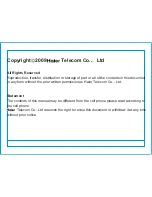
V85 Desktop VoIP Phone User Guide
49
YML772 Rev1
Appendix F: Glossary of Network and VoIP Terms
10BASE-T
A designation for the type of wiring used by Ethernet networks with
a data rate of 10 Mbps. Also known as Category 3 (CAT 3) wiring.
See also data rate, Ethernet.
100BASE-T
A designation for the type of wiring used by Ethernet networks with
a data rate of 100 Mbps. Also known as Category 5 (CAT 5) wiring.
See also data rate, Ethernet.
ADSL
Asymmetric Digital Subscriber Line. The most commonly deployed
type of DSL for home users. The term asymmetrical refers to its
unequal data rates for downloading and uploading (the download
rate is higher than the upload rate). The asymmetrical rates benefit
home users because they typically download much more data from
the Internet than they upload.
analog
Of data, having a form is analogous to the data’s original
waveform
The voice component in DSL is an analog signal.
See also digital.
ATM
Asynchronous Transfer Mode A standard for high-speed
transmission of data, text, voice, and video, widely used within the
Internet. ATM data rates range from 45 Mbps to 2.5 Gbps. See also
data rate.
authenticate
To verify a user’s identity, such as by prompting for a password.
binary
The “base two” system of numbers, that uses only two digits, 0 and
1, to represent all numbers. In binary, the number 1 is written as 1, 2
as 10, 3 as 11, 4 as 100, etc. Although expressed as decimal numbers
for convenience, IP addresses in actual use are binary numbers; e.g.,
the IP address 209.191.4.240 is 11010001.10111111.00000100.1
1110000 in binary. See also bit, IP address, network mask.
bit
Short for “binary digit,” a bit is a number that can have two values, 0
or 1. See also binary.
bps
bits per second
bridging
Passing data from your network to your ISP and vice versa using
the hardware addresses of the devices at each location. Bridging
contrasts with routing, which can add more intelligence to data
transfers by using network addresses instead. The ADSL modem can
perform both routing and bridging. Typically, when both functions
are enabled, the device routes IP data and bridges all other types of
data. See also routing.
broadband
A telecommunications technology that can send different types of
data over the same medium. DSL is a broadband technology.
Broadcast
To send data to all computers on a network.
Содержание V85
Страница 1: ......
Страница 37: ...V85 Desktop VoIP Phone User Guide 37 YML772 Rev1 Figure A 2 Continued on following page ...
Страница 38: ...38 V85 Desktop VoIP Phone User Guide YML772 Rev1 Figure A 3 Continue on following page ...
Страница 39: ...V85 Desktop VoIP Phone User Guide 39 YML772 Rev1 Figure A 4 ...
Страница 61: ......













































